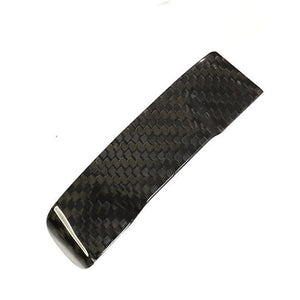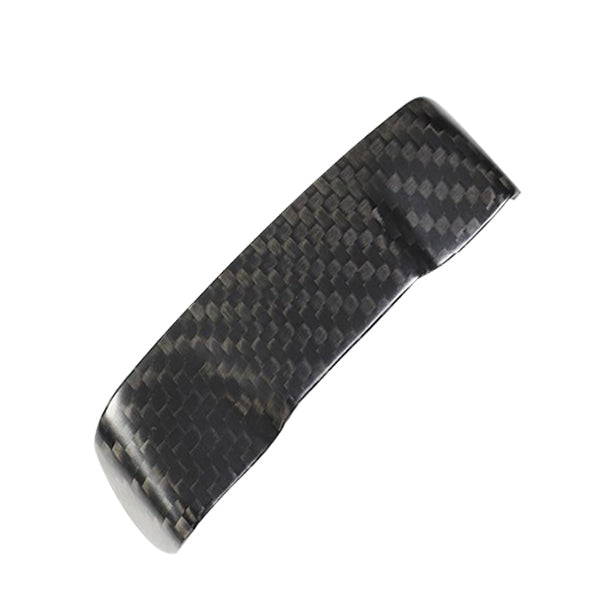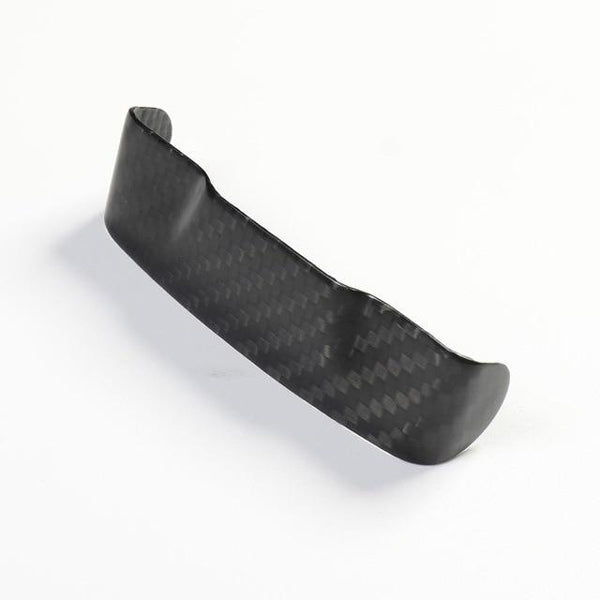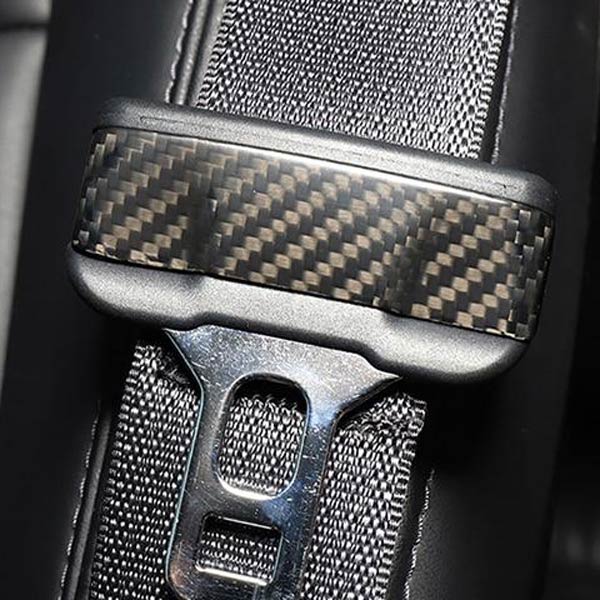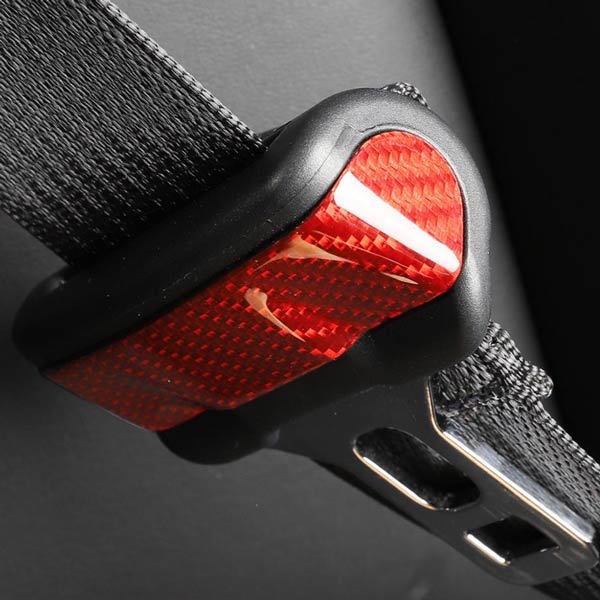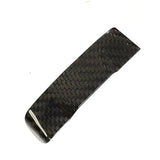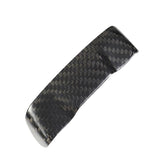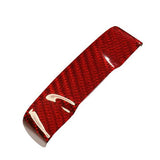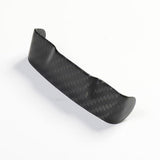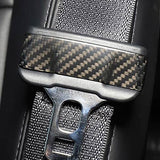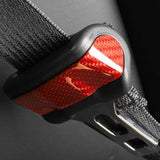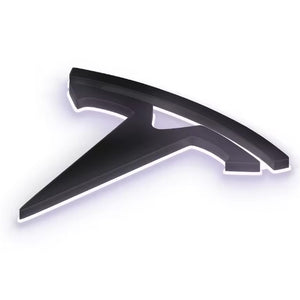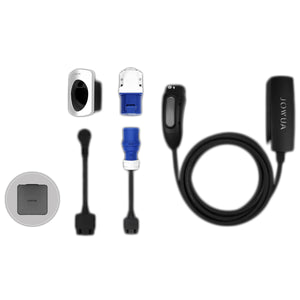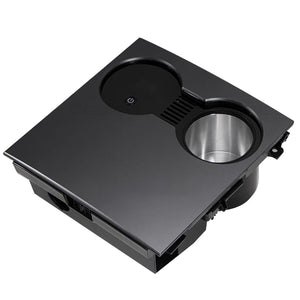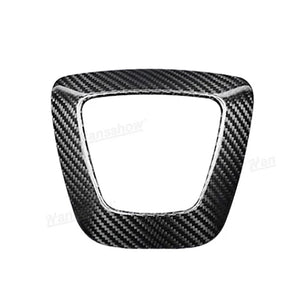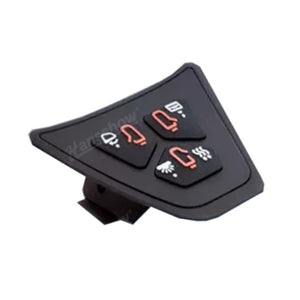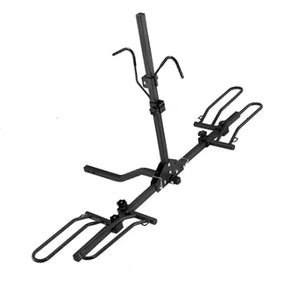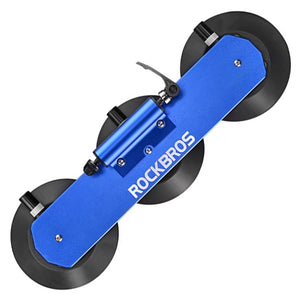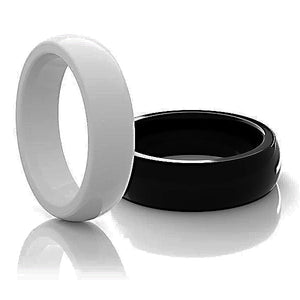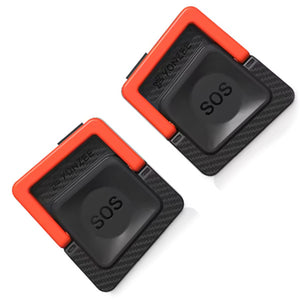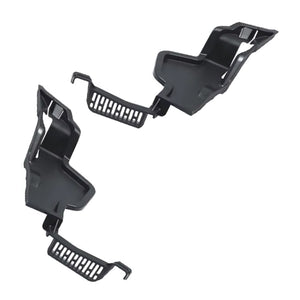Carbon belt trim
Tesla Model 3 - Y
Dress up your seat belts in the sportiest way possible, with carbon. Designed for your Model 3 and Y, these trims will simply fit, as if the location was intended.
A subtle real carbon element
A detail that will not leave indifferent fans of carbon or Texalium who will enter in your Tesla Model 3 or Y and then fasten their seat belts.
As a reminder, Texalium and a glass fabric loaded with aluminum then tinted in the mass to give this candy red color.
As with carbon fibre, we know the damage that such elements can suffer in a cabin. It is for this reason that our composite materials are made from Epoxy resin, without any finishing paint. The matte or polished finish is made directly in the mould, which will guarantee you long-lasting durability without the risk of micro-scratches.
Characteristics of the carbon belt trims for Tesla Model 3 or Y
- Original design: changes the look of your Tesla
- Perfect finish: in real carbon
- Applies easily: durable 3M double-sided
- Does not leave glue residue after uninstallation
- Sold in a kit of 2 trims
- Year of correspondence: Model 3 and Y version 2017-2020 and 2021-2023
-
2 year warranty
_________
Want to know what makes Model Sport carbon special? What is a composite material? The usefulness of a carbon part in the different industries?
We will make the argument around three main individual parts:
• It is eminent to look once and for all at what carbon really is
• The essential advantages of carbon at Model Sport
• All the improvements for your reference electric
You will be able to provide yourself with a carbon element with confidence.
What is a composite material?
By definition, what is called composite material represents the assembly of two elements together, which do not mix, but which produce an object more resistant to shocks/impacts/torsions/flexions than if they are used independently l each other.
Typically you can take reinforced concrete as an example.
What are the types of carbon or Texalium for your Tesla?
There are different types of carbon and above all several ways to present it and place it in its final position.
A distinction must be made which will be important for purists: what is commercially nicknamed "carbon" actually has the name "carbon fiber composite", this name is much more correct in the world of stratification.
3K twill in 200gr, the function of carbon fabric:
The 3K carbon in twill weave is undoubtedly the most accustomed in its category, let's start with this one. In other words, what is called "twill" is a name given to a certain way of weaving carbon. Discern what twill weave is in the picture just above.
There is a reason why twill is very noticeable: firstly its ability to adapt to molds with a strong curve, secondly its aesthetic configuration giving the impression of a diagonal weave.
However, we will not detail the type of interlacing in 3/1, 2/2 and 4/4 for the sake of understanding.
An essential thing to assimilate with regard to the "3K" attribution, this characterizes the number of strands that make up a single frame, in this case: 3000.
Information that will give you a more or less precise image of what the diameter of a strand of carbon describes: 1/20th the thickness of a human hair, so be aware of the importance of adding these latter. 1K, 3K, 6K and 12K are the most used categories in the automotive, motorcycle, aviation or other types of carbon used in large industries. For Tesla vehicles, we particularly consider 3K.
200gr/m² evokes that the carbon fabric, before its combination with the resin, weighs 200 grams for a sheet of 1 meter x 1 meter. Remember: 3K twill weighing 200 grams per square meter is widely used in the Tesla community. Not for its mechanical properties; but rather for its aesthetic configuration.
Forged carbon, let's see what this name represents:
A name that may seem abusive for an aspect that is very different from the standards, however, this molding method is in no way innovative. To roughly explain how it is produced: you have to cut each carbon frame into small pieces and then spread them evenly over the entire mold.
Then, the positive and negative molds are put under specific temperature and compression conditions once the resin is added. The process used for the manufacture of forged carbon thus gives a big advantage on rigidity and lightness, because the density of carbon obtained per square centimeter compared to the resin is higher.
Lamborghini is the pioneer in the use of forged carbon in the automotive field. However, it should be noted that forged carbon has been used in the production of warheads since the 1980s.
Texalium, the unusual:
Texalium is a completely different material, generally mistaken for carbon by amateurs.
Really, Texalium is a kind of glass fabric loaded with aluminum to give it a natural highlight. It can thus be dyed either in the mass, by mixing a dye with the resin, or on in the varnish.
You should know, however, that its mechanical properties are less than those of a usual glass fabric. And its use is purely aesthetic. Much better known in the United States, he barely manages to make himself known in France.
Learn to distinguish real carbon
We are going to present you various pieces made from this famous fiber.
We make quotes on request if you ever have a specific project in mind.
What mechanical force can be exerted on carbon?
Frequently asked, this is a request that deserves a little more in-depth development. The real question will be whether carbon is more resistant than another material?
To give you an idea: an aluminum alloy that has a physical volume equal to a carbon part will be less resistant than the latter, all stresses combined.
It is important to come back to the term “resistant”, because it means everything and nothing. Indeed, a carbon part is very resistant to bending and torsion. But less solid during an impact. This is one of the aspects of carbon that allows us to produce elements as thin as the inserts.
The dashboard insert for the Y or 3 models deserves to be mentioned: this element is only useful for its aesthetics (as for the majority of carbon elements for Tesla), but this additional part of 1 meter 40 can be produced in only two layers of carbon fabric, with a thickness not exceeding 0.5 mm and transported throughout the French country or other neighboring ones.
The reason for the cost of purchasing the carbon fabric?
To understand its final price, you must first assimilate its production:
Let's take a look at how the development of a single carbon frame takes place.
The most used is from a synthetic fiber, poly acrylonitrile, which will be oxidized and calcined to give us the famous carbon fiber. It is an entirely chemical and very energy-intensive transformation. As you can imagine, the production of carbon fiber involves a number of chemicals that are not actually good for the environment.
It is for this reason that many institutions are creating projects to continue the production of carbon fiber in the future, while drastically reducing the application of unnatural products.
The application of bio-sourced materials is gradually emerging to eliminate chemicals on the one hand and halve the price on the other. The essential material for weaving the carbon fibers is also more than substantial, in terms of investment and space. Remember that a fiber is 1/20 the thickness of a human hair.
To give you a price, which remains indicative, as it is subject to variations in the world economic price: €30 per square meter. This price is given for a 3K twill carbon tablecloth that weighs 200gr per square meter. The number of layers as well as the cost of the resin to be used are also components to be taken into account. Finally, the support of a competent laminator is essential. This in order to carry out the operations in good conditions.
Tesla Model Sport carbon features
Let's move on to the element that we master, because we follow all the manufacturing steps. It takes knowledge of the actual formatting of an element to be able to guarantee an acceptable result.
It is for this reason that the creator of the Model Sport brand, designer and bodybuilder, makes every effort to deliver its know-how in the field of carbon elements.
A carbon cloth or a slatted version?
It goes without saying that the carbon fabric is expressly used for its aesthetic configuration rather than its mechanical skills. No stress, most of the time, will be subject to the components installed on your Tesla.
Components are expressly manufactured to enhance aesthetics and highlight the aggressiveness of the brand. For the entire Tesla range, the constraints generated on the components, even a body kit, will be largely absorbed, even on a so-called "low-end" carbon.
Moreover, the most used category, even the most standard, is the HR, for "high resistance", which is very noted for its versatility and its ability to be flexible. It is exclusively this type of carbon, HR, which is used by Model Sport for the production of all its parts. We can compare it to the HM (High Modulus) which will be much lighter.
But on the other hand, it is also much more brittle, so brittle that it must be combined with HR to guarantee its function. Forged carbon illustrates this application primarily for its appearance than for its properties, however, it does have multiple characteristics.
What is the best resin to use?
Now, let's develop the centerpiece of carbon components: the resin.
For any piece that is intended for the general public and that requires mass production, polyester will be prioritized with the application of fiberglass. You should know that for carbon parts that will be very exposed to heat, polyester will also be used for its high resistance to high temperatures. You will find it in the production operation of motorcycle exhaust cartridges.
The main benefit of epoxy resin is the resistance to forces it provides compared to polyester.
The various tests have established that one resin stands out among many others: anti-UV epoxy resin. It does not tarnish over time and retains the true appearance of carbon. The sun's rays will therefore have little or no effect on your cabin or body components and the overall appearance will be more translucent.
This is a specificity that will only be felt several years after installation, but if the anti-UV treatment is not present, beware of yellowing of the parts. You will not notice anything abnormal during the purchase for sure, it is after several summers that you will begin to discern an opaque and tarnished appearance of your carbon.
Several parameters come into play when buying a resin, and this is what will partly determine its initial price: its ease of application, its long-term hold and its production quality .
To give you an order of magnitude, here are approximately the prices you can find on the French market:
• The kilo of Polyester resin is worth between 8 and 10€
• The kilo of Epoxy resin worth between 50 and 60€
• The kilo of anti-UV Epoxy resin is worth between 55 and 65€
What is the finish coat on a carbon part?
This is of course the final phase of a customization project. To guarantee an almost infinite hold over time, at the very beginning we manufactured carbon elements without any finishing paint.
The problem was that production was needed with no possibility of catching up and therefore a high rate of “waste”. This construction process gives an unacceptable scrap rate given the image that the Tesla brand wants to convey: reducing pollution and carbon waste.
We then identified a solution to "standardize" the finishing operations: the use of a superior quality varnish. Once the gloss varnish has been applied, it will be meticulously buffed to give it a polished surface. The mat, which does not benefit from any possible recovery thanks to polishing, is carried out by a professional painter in one go.
The kind of carbon on Tesla S and X vehicles
Although many elements are corresponding in the two versions, there are some differences between the years.
In most cases, we therefore call the owner, after ordering, to find out more information about the vehicle.
Model S and X interior
The Model S and X have been forgotten by props since the launch of the Model 3, however these also benefit from a range of upgrades provided. Carbon replacement elements or even inserts that will simply cover the main trim elements.
One of the main elements of your Model S or X is undoubtedly the steering wheel. This can be personalized to infinity, in twill or forged carbon, glossy or matte and leather or Alcantara trim.
The latter will have a relatively precise focus, which many other accessories will be able to benefit from in the future.
Let's move on to the Model S and X bodywork
The most sought-after body element on the Model S is undoubtedly the Performance Spoiler. As with all Model Sport spoilers, the internal structure as well as the entire bonding surface are ground in advance.
This difference will not be seen once the Spoiler is installed. We are also currently working on the Plaid version as of this writing. The grille or the mirror shells are also parts that will receive their carbon finish.
Model Sport remains flexible and will respond to your request in case you want to achieve finishes other than 3K twill carbon.
Carbon fiber on the Tesla Model 3 and Y
The Tesla Model 3 is the quintessential electric sedan of its time, with an impressive number of carbon-based upgrades.
Share a lot of similarities with the Model Y, let's see what else you can find on them.
Model 3 and Y interior
The Tesla family of owners gets a certain culture of its own, carbon inserts are part of it. A successful carbon insert must partly be finely cut so as not to manufacture an "addition" effect.
That's why it's so difficult to mass-produce it. This is where we find the exceptional skill of the inserts. Getting the Model Sport inserts to fit perfectly into the interior of the Model Y or 3 took a lot of trial and error to find the right manufacturing technique.
Precise cutting and gluing as close as possible to the components with a perfect finish, this is the recipe for a successful carbon insert for Model 3 or Y. For the most demanding owners, the replacement carbon elements also have a strong appreciation with the Tesla community.
The carbon replacement components will give an entirely different dimension to the interior of your Tesla, for meticulous people, you will obtain a finish that meets your expectations.
The body components of a Model Y or 3
As with the interior, the exterior of the Model 3 and Y has a number of possible upgrades. A good way to transform the external visual configuration, with a composition in 3K twill or forged, and matte or glossy finish.
The most requested carbon part is undoubtedly the Performance spoiler in its matt version. Having become almost a standard in the Tesla world, it will stick directly to the edge of the trunk.
In addition, you can order more essential modifications such as the replacement of the real carbon bonnet. Not only will this allow for weight loss, but will give the car a standout style.
- 🇫🇷 Gestionnaire Français
- Commandez directement au Fabricant ou au Distributeur
- Payez que votre produit (pas de frais de stockage ni de taxe territoriale)
- Livraison dans toute l'Europe !
Vous remarquerez que le bouton au-dessus vous redirige vers un des distributeurs ou fabricants du produit.
La major partie des accessoires Tesla proviennent de Chine, commander via les plateformes Aliexpress, Alibaba, Amazon, Hansshow ou Jowua vous donnera la possibilité d'obtenir le produit sans intermédiaire.
Les produits vendus en France ou en Europe proviennent du même fabricant Chinois (ou autre), mais avec une marge supplémentaire servant à payer les frais de fonctionnement de la société.
Cependant, l'avantage de commander à proximité est d'obtenir un délai de livraison plus rapide (néanmoins nous proposons aussi des produits expédiés directement depuis des stock Français ou Européens)
Model Sport a initialement commencé en faisant du stock en France, nous connaissons donc quels sont les fabricants de confiance et leur méthode de travail. Si bien que nous les citons avec leurs accords : MAOFA, BFB carbon, Yute Technologie, DCR Tuning, LITA Accessories, Jogon, Ever carbon, Carbonss Tuning, Jowua.
Ces fabricants, parmi quelques autres, sont les plus actifs et sérieux dans leur qualité de fabrication. Nous vérifions que les produits proviennent systématiquement de notre liste de fabricant. Ainsi, que vous commandiez via un distributeur Aliexpress, Amazon ou autre, nous savons que le produit sera de bonne facture.
